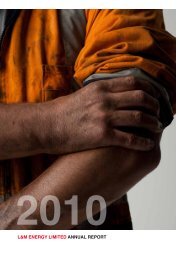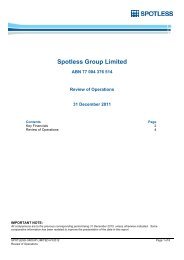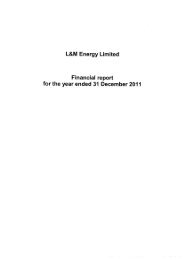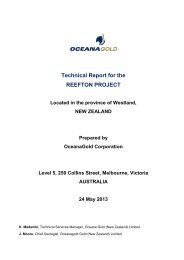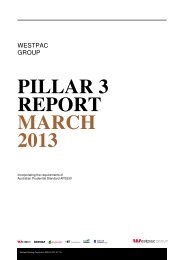NZSX/ NZDX Listing Rules APPENDIX 1 Part A (Rules 10.4.2 ... - NZX
NZSX/ NZDX Listing Rules APPENDIX 1 Part A (Rules 10.4.2 ... - NZX
NZSX/ NZDX Listing Rules APPENDIX 1 Part A (Rules 10.4.2 ... - NZX
Create successful ePaper yourself
Turn your PDF publications into a flip-book with our unique Google optimized e-Paper software.
THE 2004 AUSTRALASIAN CODE FOR REPORTING EXPLORATION RESULTS, MINERAL RESOURCES AND ORE RESERVES (THE JORC CODE)<br />
Criteria<br />
Explanation<br />
Estimation and Reporting of Diamonds and other Gemstones<br />
(criteria listed in other relevant groups also apply to this group; additional guidelines are available in the<br />
’Guidelines for the Reporting of Diamond Exploration Results‘ issued by the Diamond Exploration Best Practices<br />
Committee established by the Canadian Institute of Mining, Metallurgy and Petroleum.)<br />
Indicator minerals.<br />
Source of diamonds.<br />
Sample collection.<br />
Sample treatment.<br />
Carat.<br />
Sample grade.<br />
Reporting of<br />
Exploration Results.<br />
Grade estimation for<br />
reporting Mineral<br />
Resources and<br />
Ore Reserves.<br />
Value estimation.<br />
• Reports of indicator minerals, such as chemically/physically distinctive garnet, ilmenite,<br />
chrome spinel and chrome diopside, should be prepared by a suitably qualified laboratory.<br />
• Details of the form, shape, size and colour of the diamonds and the nature of the source<br />
of diamonds (primary or secondary) including the rock type and geological environment.<br />
• Type of sample, whether outcrop, boulders, drill core, reverse circulation drill cuttings,<br />
gravel, stream sediment or soil, and purpose, e.g. large diameter drilling to establish<br />
stones per unit of volume or bulk samples to establish stone size distribution.<br />
• Sample size, distribution and representativity.<br />
• Type of facility, treatment rate, and accreditation.<br />
• Sample size reduction. Bottom screen size, top screen size and re-crush.<br />
• Processes (dense media separation, grease, X-ray, hand-sorting etc.).<br />
• Process efficiency, tailings auditing and granulometry.<br />
• Laboratory used, type of process for micro diamonds and accreditation.<br />
• One fifth (0.2) of a gram (often defined as a metric carat or MC).<br />
• Sample grade in this section of Table 1 is used in the context of carats per units of mass,<br />
area or volume.<br />
• The sample grade above the specified lower cut-off sieve size should be reported as<br />
carats per dry metric tonne and/or carats per 100 dry metric tonnes. For alluvial deposits,<br />
sample grades quoted in carats per square metre or carats per cubic metre are<br />
acceptable if accompanied by a volume to weight basis for calculation.<br />
• In addition to general requirements to assess volume and density there is a need to relate<br />
stone frequency (stones per cubic metre or tonne) to stone size (carats per stone) to<br />
derive sample grade (carats per tonne).<br />
• Complete set of sieve data using a standard progression of sieve sizes per facies. Bulk<br />
sampling results, global sample grade per facies. Spatial structure analysis and grade<br />
distribution. Stone size and number distribution. Sample head feed and tailings particle<br />
granulometry.<br />
• Sample density determination.<br />
• Percent concentrate and undersize per sample.<br />
• Sample grade with change in bottom cut-off screen size.<br />
• Adjustments made to size distribution for sample plant performance and performance on<br />
a commercial scale.<br />
• If appropriate or employed, geostatistical techniques applied to model stone size,<br />
distribution or frequency from size distribution of exploration diamond samples.<br />
• The weight of diamonds may only be omitted from the report when the diamonds are<br />
considered too small to be of commercial significance. This lower cut-off size should<br />
be stated.<br />
• Description of the sample type and the spatial arrangement of drilling or sampling<br />
designed for grade estimation.<br />
• The sample crush size and its relationship to that achievable in a commercial treatment plant.<br />
• Total number of diamonds greater than the specified and reported lower cut-off sieve size.<br />
• Total weight of diamonds greater than the specified and reported lower cut-off sieve size.<br />
• The sample grade above the specified lower cut-off sieve size.<br />
• Valuations should not be reported for samples of diamonds processed using total<br />
liberation method, which is commonly used for processing exploration samples.<br />
• To the extent that such information is not deemed commercially sensitive, Public Reports<br />
should include:<br />
– Diamonds quantities by appropriate screen size per facies or depth.<br />
– Details of parcel valued.<br />
– Number of stones, carats, lower size cut-off per facies or depth.<br />
Note: Code is in normal typeface, guidelines are in indented italics, definitions are in bold.<br />
~ 19 ~





